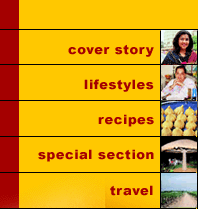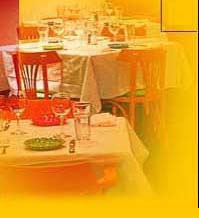


|
|
|
IN her 1999 Andhra cookbook, Bilkees I. Latif says that the cuisine is traditional, but exciting in its appeal to the palate and in its sophisticated blending of tastes. This ethnic cuisine takes its special flavour from two ingredients, she reports: tamarind and hot chillies. It is true. And it is that way in Visakhapatnam especially. Though the food of this old port city, because of its rich coastal belt, is different from elsewhere in Andhra Pradesh. It is influenced greatly by the presence of river and sea fish on the menu. The one thing nobody does in Vizag is seek out Hyderabadi food. It is, of course, available on most restaurants� menus. Hyderabad is close to Vizag. But fortunately, the influence of its rich and sophisticated Mughlai cuisine is not overbearing on the food and eating habits of the Andhraite living by the coast.
Traditionally, meals are had sitting on the floor and out of a banana leaf. Modern families have improvised. They use steel thalis. And restaurants specialising in coastal Andhra food, do an ethnic number by laying a banana leaf in a thali! Try eating from the banana leaf. It is an experience. The flavours of the food are enhanced and the meal itself will seem more enjoyable. Much of the food is rice-based, that�s because Andhra Pradesh grows a lot of rice. The soil and climate in the state is very conducive for cultivation of rice. However, the farmers here do not grow a fancy, designer rice like Basmati. Andhra rice is cheap.
Another peculiarity of coastal Andhra food is that it is spicy. Both, the vegetarian and non-vegetarian cuisines are spicy. It is the fiery Guntur variety of the Andhra chilli that contributes the spice to the food.
There is also the Gongura Chutney or Pachedi, another delicacy in Vizag, enjoyed with steaming hot rice, ghee and chopped onions. It is the use of distinctive spices which creates different flavours in the cuisine and subtle variations in taste and aroma.
A coastal non-vegetarian meal would include one dish of biryani or Pulihora or vegetable pulao, one dish of chicken or meat with rich savoury ingredients, or a kabab, one seafood dish, one curry of chicken or meat with gravy, a dish of lentils (dal) with gravy, which could have vegetables in it, two leafy or green vegetable dishes, one of which could be okra, broad beans or cluster beans or beans of any variety, or, if in season, jackfruit, a dish of Poriyal and one dish of rasam, which is light and very liquid, served and eaten with plain boiled rice.
The meal is accompanied by different types of chutneys that have their base in some kind of dal and sesame seeds or oil, and coconut. Chutneys are made of curry leaves, coconut, mango, and all kinds of vegetables. There is even an unusual and exciting ginger chutney in the cuisine. Curiously, people in Vizag are divided in their choice of fish. They will either have it from the sea or from the river. Seafood means the catch from the Bay, saltwater fish, and it is prawn, lobster, squid, the Bekti, black and white Pomfret, Sardine, crab, Mackerel, and even the Red Snapper.
Fish is cooked either as a Pulusu, which is a thin, watery, reddish-brown curry, spiced with red chilli and given a tangy flavour with tamarind. Or it would be cooked as a Vepudu, which is a deep-fried preparation with chilli powder and tossed with curry leaves. There is also the Iguru, a thick masala, like a gassi would be in Mangalore. Chicken is popular with people in Vizag and so in mutton. They are health conscious despite the passion for chilli hot food, and go for a good broiler which will be made into a home-style curry with curry leaves. Egg curries and the egg pepper roast is also popular. The population is predominantly Hindu, so mutton is the accepted meat, not beef or pork.
What Vizag makes up in, however, is its own version of the biryani. It is known simply as the Andhra biryani, a very spicy preparation that has little in common with the Hyderabadi biryani. In Vizag, they add a lot of red Guntur chilli powder and whole green chillies along with the basic garam masala to the Biryani. And they add curd as well. There is a concession made for the Andhra biryani. It is made out of Basmati rice. Besides the biryani, they do an Andhra fried rice in Vizag that is fairly unusual for any cuisine. It is not a pulao though it has a lot of vegetables cut into small dices and added to it. The fried rice is tempered with curry leaves and mustard seeds, and channa dal, broken cashewnuts and jeera are added. The plain variety of Andhra rice is used for this dish.
Visitors to Vizag end up developing a liking for the sweetmeats and then buying great quantities of them from the sweet shops and taking them back home with them. There are a number of excellent sweetmeat shops in the city where you could actually sample each sweet before you buy it!
|

Home Page
About the mag
Subscribe
Advertise
Contact Us

 Peethala Khurma & Royyalu Miriyalu
Peethala Khurma & Royyalu Miriyalu
 And besides, Vizag has a cuisine entirely its own. It is coastal Andhra food. �Coastal� does not necessarily mean seafood. The Vizag gourmet is grateful for the catch from the Bay of Bengal, naturally, but his coastal food is a healthy balance of vegetarian and non-vegetarian food.
Also, unlike the ceremonial (and royal!) dining habits of the people of Hyderabad, the style of eating in Vizag is homely South Indian. It is Telugu-style, irrespective of whether the meal is vegetarian or non-vegetarian.
And besides, Vizag has a cuisine entirely its own. It is coastal Andhra food. �Coastal� does not necessarily mean seafood. The Vizag gourmet is grateful for the catch from the Bay of Bengal, naturally, but his coastal food is a healthy balance of vegetarian and non-vegetarian food.
Also, unlike the ceremonial (and royal!) dining habits of the people of Hyderabad, the style of eating in Vizag is homely South Indian. It is Telugu-style, irrespective of whether the meal is vegetarian or non-vegetarian.  Grain vendors in market places will proudly display sacks of the rice varieties and extol the virtues of each. The popular brands are Ponni, Nellore, Sanalu and Awadhwada. And people in Vizag think nothing of having rice in their meals for breakfast, lunch and dinner.
Grain vendors in market places will proudly display sacks of the rice varieties and extol the virtues of each. The popular brands are Ponni, Nellore, Sanalu and Awadhwada. And people in Vizag think nothing of having rice in their meals for breakfast, lunch and dinner.  Guntur is the largest producer of chilli in Andhra and its chilli is reputed for its pungency and for lending a bright red colour to food. Because they eat such spicy food and run the risk of damaging their stomachs, the Andhraites conclude their meals with a dish of curd and rice.
But they like their food spicy. And they add more fire to it with a variety of tangy chutneys and pungent pickles. These are compulsory with their meals. There is a mango pickle called Aavakaya in which the Guntur red chilli is powdered and mixed with mustard powder and sesame oil, some
asafoetida and fenugreek seeds. It is an awesome preparation.
Guntur is the largest producer of chilli in Andhra and its chilli is reputed for its pungency and for lending a bright red colour to food. Because they eat such spicy food and run the risk of damaging their stomachs, the Andhraites conclude their meals with a dish of curd and rice.
But they like their food spicy. And they add more fire to it with a variety of tangy chutneys and pungent pickles. These are compulsory with their meals. There is a mango pickle called Aavakaya in which the Guntur red chilli is powdered and mixed with mustard powder and sesame oil, some
asafoetida and fenugreek seeds. It is an awesome preparation.  A typical coastal vegetarian Andhra meal would include a Pulihora or vegetable pulao, one savoury dish of okra, brinjal or beans of any variety, one vegetable curry of yam and carrots or a Dhapala, of several vegetables, one lentil (dal) dish with lots of gravy, a Pulusu which could have bottle gourd and tomatoes in it, followed by a light rasam to be eaten with plain boiled rice and a dish of curds. The menu would also include Poriyal, a finely chopped salad of vegetables seasoned with mustard and salt and garnished with freshly grated coconut.
A typical coastal vegetarian Andhra meal would include a Pulihora or vegetable pulao, one savoury dish of okra, brinjal or beans of any variety, one vegetable curry of yam and carrots or a Dhapala, of several vegetables, one lentil (dal) dish with lots of gravy, a Pulusu which could have bottle gourd and tomatoes in it, followed by a light rasam to be eaten with plain boiled rice and a dish of curds. The menu would also include Poriyal, a finely chopped salad of vegetables seasoned with mustard and salt and garnished with freshly grated coconut. An Andhra coastal meal is had in courses. The main course will (and must!) include rice, dal, vegetables, the chicken, meat and fish, the sambar and rasam, and the last course, the curd-rice. This dish is a must for every Andhraite. It cools the stomach after the fiery meal and hastens digestion of the heavy and spicy rice-based meal.
An Andhra coastal meal is had in courses. The main course will (and must!) include rice, dal, vegetables, the chicken, meat and fish, the sambar and rasam, and the last course, the curd-rice. This dish is a must for every Andhraite. It cools the stomach after the fiery meal and hastens digestion of the heavy and spicy rice-based meal.  Whereas, river fish is sweetwater fish, there is plump and succulent prawn from the Godavari, the local fish Bombadulu, Korameen, Marpulu and Rohu.
Whereas, river fish is sweetwater fish, there is plump and succulent prawn from the Godavari, the local fish Bombadulu, Korameen, Marpulu and Rohu.  There is no influence of Christian food on coastal Andhra cuisine at all. Nor, really, a great Mughlai influence despite the proximity. Vizag will have a Biryani on its menu, but not Pathar ka Gosht or a Haleem.
There is no influence of Christian food on coastal Andhra cuisine at all. Nor, really, a great Mughlai influence despite the proximity. Vizag will have a Biryani on its menu, but not Pathar ka Gosht or a Haleem. Finally, the desserts. They are rice-based, naturally, or made with channa dal, milk, sugar or jaggery. People are used to having Payasams and the Sooji Halwa, but they are more fond of eating Andhra sweetmeats after their meals like the Khaja, Pootherekulu, Boorulu, Bobattlu, Sunnudalu and Arisulu. Some are made with rice flour, others with urad dal, channa dal, and they are sweetened with sugar and jaggery. The cooking medium is ghee and sometimes, also dalda.
Finally, the desserts. They are rice-based, naturally, or made with channa dal, milk, sugar or jaggery. People are used to having Payasams and the Sooji Halwa, but they are more fond of eating Andhra sweetmeats after their meals like the Khaja, Pootherekulu, Boorulu, Bobattlu, Sunnudalu and Arisulu. Some are made with rice flour, others with urad dal, channa dal, and they are sweetened with sugar and jaggery. The cooking medium is ghee and sometimes, also dalda.